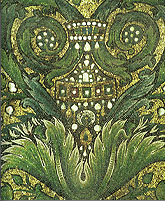|

The Origins of the Arabic Script
|
The Arabic script appeared many centuries before the rise of Islam. In the Land of Israel, Arabic writing is encountered from as early as the Hellenistic and Early Roman periods in Nabatene documents. (The most important of these were discovered in the Cave of the Letters in Nahal Hever, dating to the reign of the last Nabatean king - Rav`el II.) The Arabic script emerged from the northeastern tribes of Arabia and spread westward. At the beginning of the sixth century CE this script was adopted by the aristocratic tribe of Quraysh (Muhammad's tribe) in Mecca, and then in Al-Madina. The earliest evidence of a matured Arab script is found in two documents: the Malqat - a corpus of seven great poems composed around 500 CE; and the Qur`an - first edited in 653 by caliph Othman b. Afan. This Qur`an is the prototype for the edition of the Qur`an to this day. |
|
During the Umayyad period the study of Arabic linguistics developed rapidly, especially following the numismatic reform of 'Abd al-Malik, which included the affirmation of Arabic as the formal language of the Empire. This development took place in the cities of Kufa and Basra.
|
|
Arabic sources relate that the early Arab scholars of linguistics would set out to the desert in order to study the language of the Bedouins, which had not absorbed foreign elements, such as of Aramaic, Persian and Turkish. They assembled poems, proverbs and stories, and put them into writing. Their work brought about a reform that included the introduction of diacritics above and below the letters, thus facilitating the reading process. This reform resulted in several epigraphic formats, which consequently led to the development of Arabic calligraphy. |

|


